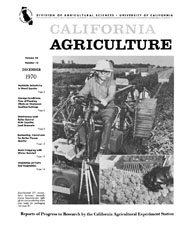


University of California
California Agriculture
|
|||
|
|||

Cover:
Experimental UC boysenberry harvester instantly freezes boysenberries right off the vine producing clean fruit ready for packaging.
December 1970
Volume 24, Number 12 |
|||
|
University of California, 1301 S. 46th St., Bldg. 478 Richmond, CA
|